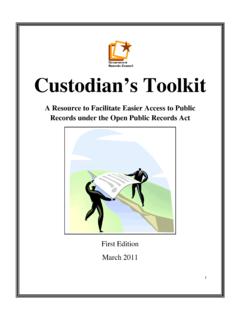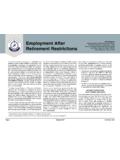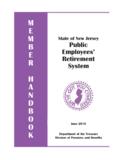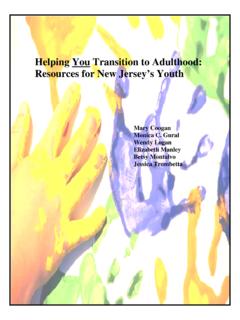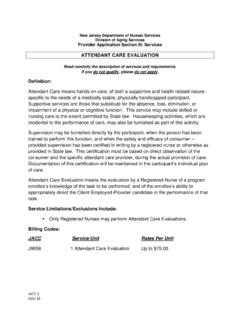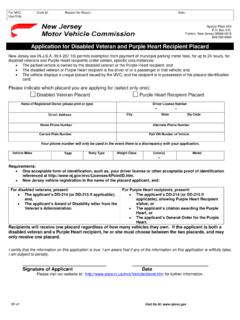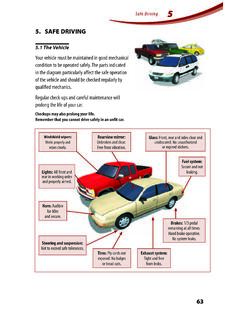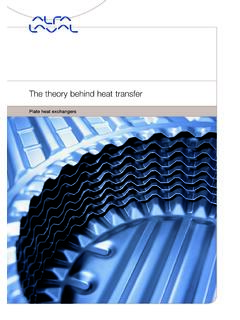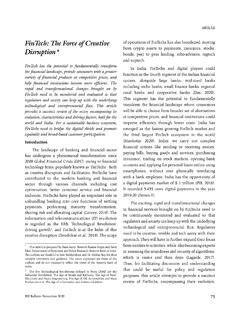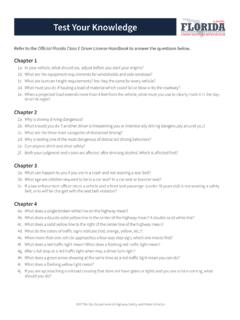Transcription of Use of Force Policy Addendum B Vehicular Pursuit Policy
1 Use of Force Policy Addendum B. Vehicular Pursuit Policy Contents 1 Purpose of 1. 2 Definitions .. 2. 3 Deciding Whether to Pursue .. 4. 4 Role of the Pursuing Officer .. 7. 5 Vehicular Pursuit Restrictions .. 8. 6 Authorized Tire Deflation Devices .. 10. 7 Role of the Supervisor .. 12. 8 Role of Police Communications .. 13. 9 Reinstating Pursuits .. 13. 10 Interjurisdictional Pursuits .. 13. 11 Vehicular Pursuit Reporting .. 14. 12 Vehicular Pursuit Review .. 15. 13 Training .. 16. 14 Individual Agency Policies .. 16. 1 Purpose of Policy The primary purpose of this Policy is to secure a balance between the protection of the lives and safety of the public and police officers, and law enforcement's duty to enforce the law and apprehend violators. This Policy is intended to guide the circumstances under which officers may engage in Vehicular pursuits.
2 High-speed Vehicular pursuits create a substantial risk of injury and fatalities. Over 10% of Vehicular pursuits end up in accidents resulting in injuries or fatalities, including to officers, innocent third parties in vehicles unrelated to the Pursuit , and pedestrians. The Pursuit Policy was last updated in 2009. The Policy succeeded initially in reducing the number of pursuits, injuries, and fatalities associated with them. However, after an initial decline, the number of pursuits has been increasing steadily since 2014. Since the Policy was updated there have been almost 4,200 accidents during pursuits that resulted in over 2,800 injuries, including injuries to 625 law enforcement officers, 682 victims in third party vehicles, and 52 pedestrians. In that same period, there have been 59 fatalities associated with pursuits, including an officer, four third-party drivers, and eight pedestrians.
3 In recognition of this data and the substantial human costs associated with high-speed Vehicular pursuits, this Policy further restricts the circumstances under which pursuits can be undertaken. The offenses for which officers may pursue suspects has been limited to only the most serious crimes. Significantly, both auto theft and most drug offenses have been removed from the list of crimes authorizing the initiation of a Pursuit . This Policy creates a strong presumption against the initiation of pursuits for traffic violations and prohibits continuation of a Pursuit based on the risk created by the speed or evasive driving of the fleeing suspect during the Pursuit itself. It also requires greater oversight by supervisors, and mandates that a Pursuit be terminated unless a supervisor affirmatively authorizes it to be continued.
4 Deciding whether to pursue a motor vehicle is among the most critical decisions made by law enforcement officers. It is a decision which must be made quickly and under difficult, often unpredictable circumstances. In recognition of the potential risk to public and officer safety created by Vehicular pursuits, no officer or supervisor shall be criticized or disciplined for a decision not to engage in a Vehicular Pursuit or to terminate an ongoing Vehicular Pursuit based on the risk involved, even in circumstances where this Policy would permit the commencement or continuation of the Pursuit . Likewise, officers who conduct pursuits consistent with this Policy will be strongly supported by the law enforcement community in any subsequent review of such actions. USE OF Force Policy Addendum B | December 2020 1. Vehicular Pursuit Policy 2 Definitions Authorized Tire Deflation Device.
5 A device designed and intended to produce a controlled deflation of one or more tires of a pursued vehicle and capable of operation consistent with criteria established in this Policy . Boxing In. The surrounding of a violator's moving vehicle with moving Pursuit vehicles which are then slowed to a stop along with the violator's vehicle. Divided Highway. A road which includes a physical barrier between traffic traveling in opposite directions. Heading Off. An attempt to terminate a Pursuit by pulling ahead of, behind , or toward a violator's moving vehicle to Force it to the side of the road or to otherwise come to a stop. Law Enforcement Officer. Any person who is employed as a sworn member of any State, county, or municipal law enforcement agency, department, or division of those governments who is statutorily empowered to act for the detection, investigation, arrest, conviction, detention, or rehabilitation of persons violating the criminal laws of this State.
6 The term law enforcement officer shall include sworn members of the New Jersey State Police, the Division of Criminal Justice and the Juvenile Justice Commission. It shall include State Correctional Police Officers pursuant to 2A:154-4, County Correctional Police Officers pursuant to 2A:154-3, Special Law Enforcement Officers of all classes pursuant to 40 et seq., Humane Law Enforcement Officers appointed pursuant to 4 or 4 , Auxiliary Police Officers appointed pursuant to :9-45(c), and Constables appointed pursuant to 40A:9-120. For purposes of this Policy , the terms law enforcement officer, police officer and officer shall have the same meaning. Paralleling. Street Paralleling is driving a police vehicle on a street parallel to a street on which a Pursuit is occurring. Vehicle Paralleling is a deliberate offensive tactic by one or more patrol vehicles to drive alongside the pursued vehicle while it is in motion.
7 Pursuit Driving. Pursuit driving is an active attempt by a law enforcement officer operating a motor vehicle and utilizing emergency warning lights and an audible device to apprehend one or more occupants of another moving vehicle when the officer reasonably believes that the driver of the fleeing vehicle is aware of the officer's attempt to stop the vehicle and is resisting apprehension by increasing vehicle speed, committing traffic violations or otherwise attempting to elude the officer. It shall not constitute Pursuit driving if the fleeing vehicle follows all traffic regulations after the officer activates the emergency warning lights and audible device (siren). USE OF Force Policy Addendum B | December 2020 2. Vehicular Pursuit Policy Pursuit Vehicles. A Primary Unit is the police vehicle that initiates a Pursuit or any unit that assumes control of the Pursuit as the lead vehicle (the first police vehicle immediately behind the fleeing suspect).
8 A Secondary Unit is any police vehicle which becomes involved as a backup to the primary unit and follows the primary unit at a safe distance. Roadblock. A restriction or obstruction used or intended for the purpose of preventing free passage of motor vehicles on a roadway in order to effectuate the apprehension of a violator. An avenue of escape is a gap in a roadblock which requires the violator to decrease the vehicle's speed to permit the violator to bypass the roadblock. A blocking vehicle is a motor vehicle, often a law enforcement vehicle, which is placed perpendicular to a roadway or angled in such a way as to create a roadblock. Supervisor. A police officer who, by virtue of rank or assignment, is responsible for the direction or supervision of the activities of other police officers. Vehicle Contact Action. Any action undertaken by the pursuing officer intended to result in contact between the moving police vehicle and the pursued vehicle.
9 Violator. Any person who an officer reasonably believes (1) has committed, or is engaged in a conspiracy or attempt to commit, any crime of the first degree or one of the violent or serious crimes of the second degree enumerated in Section of this Policy , or (2) poses an imminent threat to the safety of the public or other police officers, as that threat is defined in Section of this Policy , set forth below. USE OF Force Policy Addendum B | December 2020 3. Vehicular Pursuit Policy 3 Deciding Whether to Pursue A law enforcement officer has the authority, at all times, to attempt the stop of any person suspected of having committed any criminal offense or traffic violation. When the violator does not submit to the officer's lawful authority and bring the vehicle to a stop, the officer must determine whether to pursue that violator by continuing to attempt to stop the violator utilizing Pursuit driving as defined herein.
10 The officer's decision to pursue should always be undertaken with an awareness of the degree of risk to which the officer exposes law enforcement and the community by engaging in a Vehicular Pursuit . The officer must always weigh the need for immediate apprehension against the risk created by the Pursuit . A law enforcement officer may only pursue under the circumstances described in subparagraph A or subparagraph B: (a) when the officer reasonably believes that the violator has committed, or is engaged in a conspiracy or attempt to commit, any crime of the first degree or one of the following violent or serious crimes of the second degree: (1) Manslaughter, 2C:11-4;. (2) Vehicular Homicide, 2C:11-5;. (3) Aggravated Assault, 2C:12-1(b);. (4) Disarming a Law Enforcement Officer, 2C:12-11;. (5) Kidnapping, 2C:13-1;. (6) Luring/Enticing a Child, 2C:13-6.
